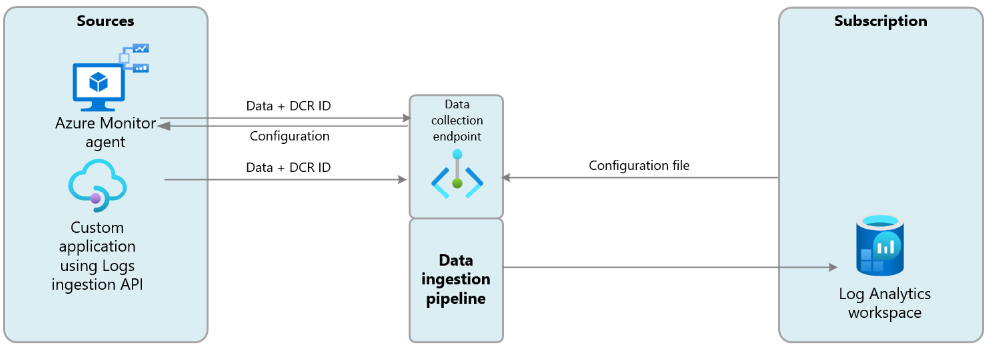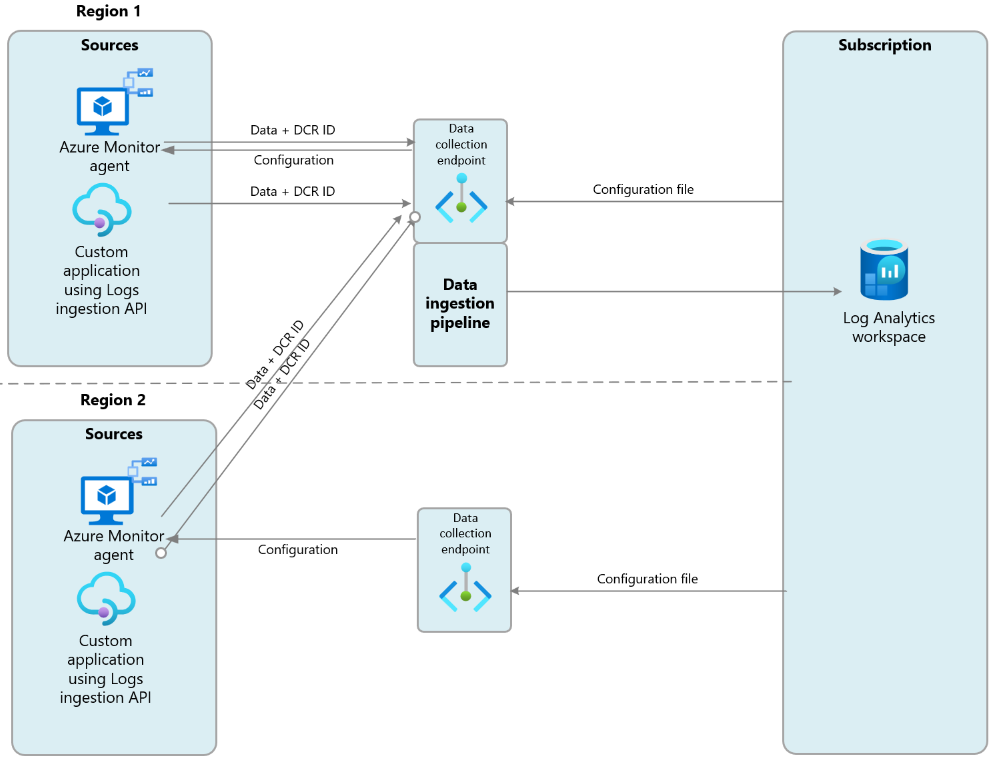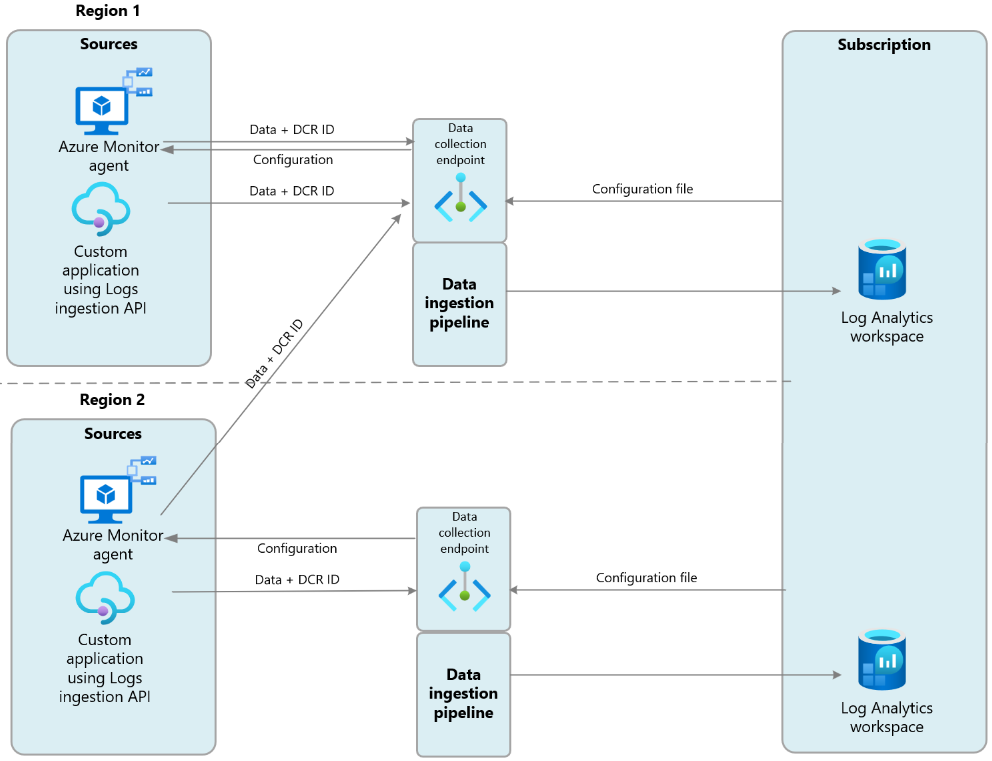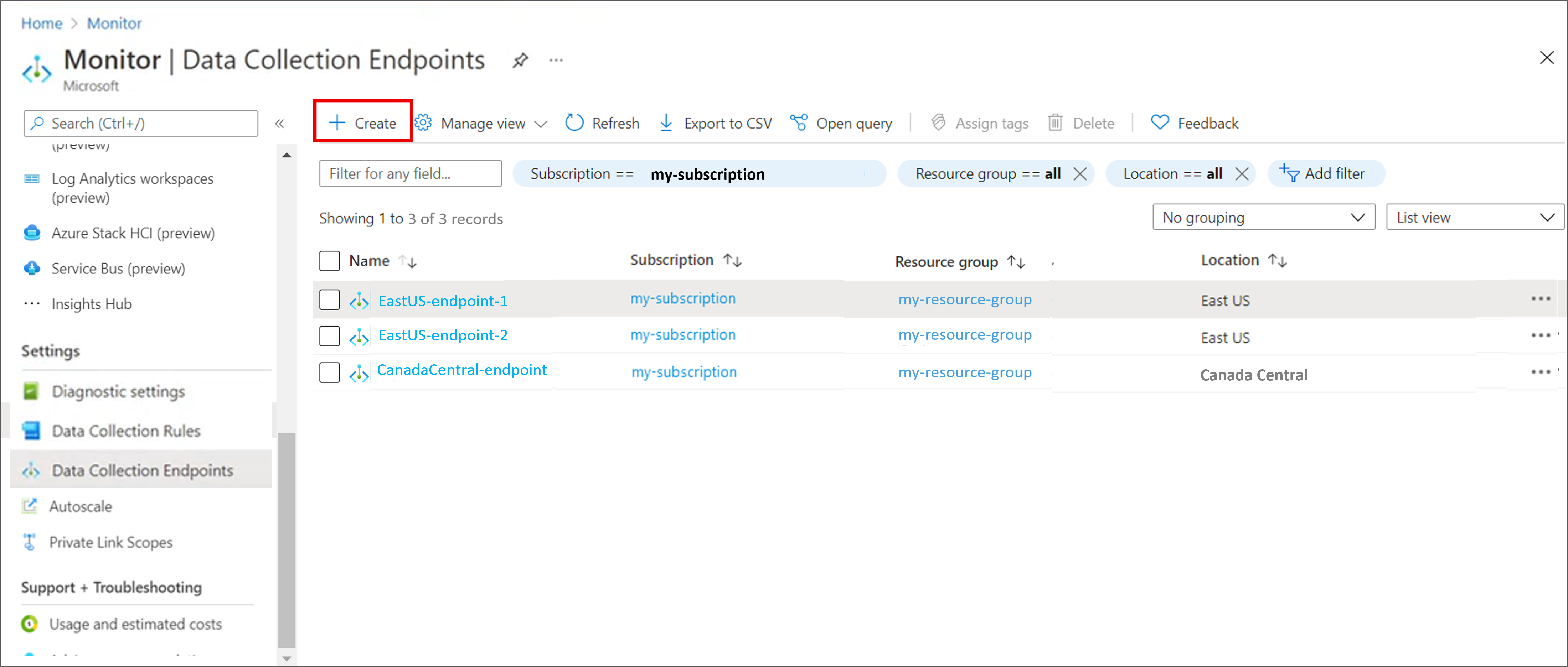Azure Monitor のデータ収集エンドポイント
データ収集エンドポイント (DCE) は、Logs Ingestion API が収集されたデータを処理と取り込みのために Azure Monitor に送信するために使う接続です。 Azure Monitor エージェントも、データ収集エンドポイントを使って、Azure Monitor から構成ファイルを受け取ったり、収集されたログ データを処理と取り込みのために送信したりします。
この記事では、データ収集エンドポイントの概要と、デプロイに基づいてそれを作成および設定する方法について説明します。
データ収集エンドポイントのコンポーネント
データ収集エンドポイントには、Azure Monitor へのデータの取り込みと、Azure Monitor エージェントへの構成ファイルの送信のために必要なコンポーネントが含まれています。
デプロイ用にエンドポイントを設定する方法は、監視対象のリソースと Log Analytics ワークスペースが存在するリージョンが 1 つか複数かによって異なります。
次の表では、データ収集エンドポイントのコンポーネント、関連するリージョンについての考慮事項、ポータルを使ってデータ収集ルールを作成するときにデータ収集エンドポイントを設定する方法について説明します。
| コンポーネント | 説明 | リージョンに関する考慮事項 | データ収集ルールの構成 |
|---|---|---|---|
| ログ インジェスト エンドポイント | データ インジェスト パイプラインにログを取り込むエンドポイント。 Azure Monitor は、データを変換し、収集されたデータと共に送信された DCR ID に基づいて、定義された送信先の Log Analytics ワークスペースとテーブルにそれを送信します。 例: <unique-dce-identifier>.<regionname>-1.ingest。 |
送信先の Log Analytics ワークスペースと同じリージョン。 | ポータルを使ってデータ収集ルールを作成するときに、[基本] タブで設定します。 |
| 構成アクセス エンドポイント | Azure Monitor エージェントがデータ収集ルール (DCR) を取得するエンドポイント。 例: <unique-dce-identifier>.<regionname>-1.handler.control。 |
監視対象のリソースと同じリージョン。 | ポータルを使ってデータ収集ルールを作成するときに、[リソース] タブで設定します。 |
デプロイに基づいてデータ収集エンドポイントを設定する方法
シナリオ: すべての監視対象リソースが、送信先の Log Analytics ワークスペースと同じリージョンにある
構成ファイルの送信と収集されたデータの受信のために、1 つのデータ収集エンドポイントを設定します。
シナリオ: 監視対象リソースが別のリージョンの Log Analytics ワークスペースにデータを送信する
Azure Monitor エージェントをデプロイする各リージョンにデータ収集エンドポイントを作成し、構成ファイルをそのリージョンのエージェントに送信します。
すべてのリソースから、送信先の Log Analytics ワークスペースが配置されているリージョンのデータ収集エンドポイントに、データを送信します。
シナリオ: 1 つ以上のリージョンの監視対象リソースが、別のリージョンの複数の Log Analytics ワークスペースにデータを送信する
Azure Monitor エージェントをデプロイする各リージョンにデータ収集エンドポイントを作成し、構成ファイルをそのリージョンのエージェントに送信します。
送信先の Log Analytics ワークスペースがある各リージョンにデータ収集エンドポイントを作成し、そのリージョンの Log Analytics ワークスペースにデータを送信します。
監視対象の各リソースから、送信先の Log Analytics ワークスペースが配置されているリージョンのデータ収集エンドポイントに、データを送信します。
Note
既定では、Microsoft.Insights リソース プロバイダーはサブスクリプション内に登録されていません。 データ収集エンドポイントを作成しようとする前に、それを必ず正常に登録してください。
データ収集エンドポイントを作成する
サンプルのデータ収集エンドポイント
以下のサンプル データ収集エンドポイント (DCE) は、Azure Monitor エージェントを使用する仮想マシン用であり、パブリック ネットワーク アクセスが無効になっているので、エージェントではプライベート リンクのみを使用して通信を行い、Azure Monitor または Log Analytics にデータを送信します。
{
"id": "/subscriptions/xxxxxxxx-xxxx-xxxx-xxxx-xxxxxxxxxx/resourceGroups/myResourceGroup/providers/Microsoft.Insights/dataCollectionEndpoints/myCollectionEndpoint",
"name": "myCollectionEndpoint",
"type": "Microsoft.Insights/dataCollectionEndpoints",
"location": "eastus",
"tags": {
"tag1": "A",
"tag2": "B"
},
"properties": {
"configurationAccess": {
"endpoint": "https://mycollectionendpoint-abcd.eastus-1.control.monitor.azure.com"
},
"logsIngestion": {
"endpoint": "https://mycollectionendpoint-abcd.eastus-1.ingest.monitor.azure.com"
},
"networkAcls": {
"publicNetworkAccess": "Disabled"
}
},
"systemData": {
"createdBy": "user1",
"createdByType": "User",
"createdAt": "yyyy-mm-ddThh:mm:ss.sssssssZ",
"lastModifiedBy": "user2",
"lastModifiedByType": "User",
"lastModifiedAt": "yyyy-mm-ddThh:mm:ss.sssssssZ"
},
"etag": "xxxxxxxx-xxxx-xxxx-xxxx-xxxxxxxxxxxx"
}
制限事項
データ収集エンドポイントでは、収集されたデータの宛先として Log Analytics ワークスペースのみがサポートされます。 現在、Azure Monitor エージェントを介して収集およびアップロードされたカスタム メトリック (プレビュー) は、DCE によって制御されません。
データ収集エンドポイントは、Logs Ingestion API のインジェスト制限が適用される場所です。




